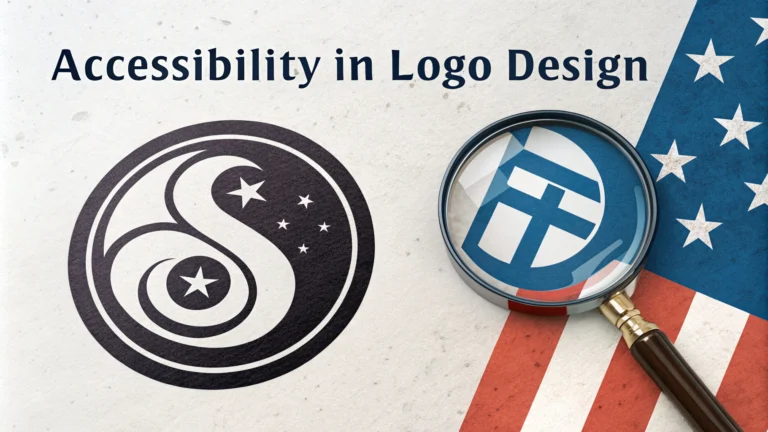Accessible logo design ensures your brand identity connects with everyone, including people with visual impairments or other disabilities.
Good accessibility in logos starts with strong contrast between elements – aim for a minimum contrast ratio of 4.5:1 between text and background colors.
Key Elements of Accessible Logo Design
- Simple, clean shapes that remain recognizable when scaled down
- Clear spacing between design elements
- Readable fonts without decorative features
- Color combinations that work for colorblind users
- Alternative versions for different use cases
Color Considerations
Test your logo in grayscale to ensure it remains effective without color.
Size Adaptability
- Create versions for large displays (billboards, signage)
- Design scalable versions for small screens (mobile apps, favicons)
- Test readability at different sizes
Format Recommendations
| Format | Best Use Case |
|---|---|
| SVG | Web and scalable applications |
| PNG | Digital displays with transparency |
| JPG | Print materials |
Practical Tips
- Include text alternatives for digital applications
- Maintain consistent branding across all versions
- Document accessibility features for future reference
- Get feedback from users with different abilities
Test your logo across multiple platforms and devices to ensure consistent accessibility.
Regular accessibility audits help maintain and improve your logo’s effectiveness across all user groups.
Implementation Guidelines
Building accessibility into your logo from the start saves time and resources compared to retrofitting later. Consider accessibility requirements during the initial design phase.
Documentation Requirements
- Detailed color specifications with contrast ratios
- Minimum and maximum size requirements
- Clear usage guidelines for different backgrounds
- Instructions for alternative versions
Testing Protocol
- Screen reader compatibility checks
- Mobile device rendering tests
- Print quality verification
- Social media platform compatibility
Maintenance and Updates
Establish a regular review schedule to ensure your logo maintains accessibility standards as technology and platforms evolve.
Annual Review Points
- Digital format compatibility
- Platform-specific requirements
- User feedback integration
- Accessibility standards compliance
Conclusion
Accessible logo design is not just about compliance – it’s about creating an inclusive brand identity that reaches all audiences effectively. Regular testing, documentation, and updates ensure your logo remains accessible across evolving digital and physical environments.
Remember to:
- Keep accessibility at the forefront of design decisions
- Test regularly with diverse user groups
- Maintain comprehensive documentation
- Stay current with accessibility standards
FAQs
- What makes a logo design accessible?
An accessible logo design is one that is clear, legible, and easily recognizable across different sizes, mediums, and by people with various visual abilities. It should work well in both color and monochrome, maintain visibility at small sizes, and have sufficient contrast ratios. - Why is color contrast important in accessible logo design?
Color contrast is crucial because it ensures the logo is visible to people with color vision deficiencies and meets WCAG guidelines. A minimum contrast ratio of 4.5:1 between text and background colors is recommended for optimal readability. - Should an accessible logo work in black and white?
Yes, an accessible logo must work effectively in black and white or monochrome versions. This ensures visibility in various applications, printing limitations, and for users with color blindness or visual impairments. - What font characteristics make a logo more accessible?
Accessible logos use clear, legible fonts with adequate spacing. Sans-serif fonts are often preferred for their readability. Letters should not be too tightly spaced, and the font weight should be substantial enough to remain visible at smaller sizes. - How does scaling affect logo accessibility?
A logo must maintain its clarity and readability when scaled down for mobile devices or up for large displays. Details should not become muddled at small sizes, and simple designs typically scale better than complex ones. - What role does negative space play in accessible logo design?
Negative space helps improve logo clarity and readability by providing visual breathing room between elements. Proper use of negative space prevents visual clutter and ensures the logo remains distinguishable at various sizes. - How can logos be made accessible for color-blind users?
Logos should not rely solely on color to convey meaning. Using distinct shapes, patterns, and ensuring the design works in grayscale helps make logos accessible to color-blind users. - What file formats are best for accessible logo design?
Vector formats (SVG, AI, EPS) are ideal for accessible logos as they maintain clarity at any size. SVG formats are particularly important for web accessibility as they scale smoothly and can include alternative text. - How important is simplicity in accessible logo design?
Simplicity is crucial for accessibility. Simple logos are more memorable, easier to recognize, and maintain their integrity across different sizes and applications. Complex designs can become illegible when scaled down. - What testing methods ensure logo accessibility?
Testing should include viewing the logo at various sizes, checking color contrast ratios, testing with color blindness simulators, ensuring readability on different backgrounds, and validating across multiple devices and print materials.








